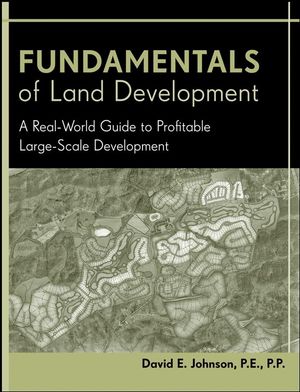Fundamentals of Land Development: A Real-World Guide to Profitable Large-Scale DevelopmentISBN: 978-0-471-77893-6
Hardcover
336 pages
March 2008
 This is a Print-on-Demand title. It will be printed specifically to fill your order. Please allow an additional 10-15 days delivery time. The book is not returnable.
|
||||||
Preface.
Acknowledgements.
Disclaimer.
Chapter 1. Comprehensive Site Planning Overview.
1.1 Introduction.
1.2 Role of Government.
1.3 Public Perceptions.
1.4 Builder and Developer Vision.
1.5 Design Professional Leadership.
1.6 Land Plan Concepts.
1.7 Summary.
Discussion Topics.
Chapter 2. Site Analysis.
2.1 Introduction.
2.2 Soil Analysis.
2.3 Slope and Topography Analysis.
2.4 Existing Land Characteristics.
2.5 Wetland and Conservation Analysis.
2.6 Flood Plains and Steam Corridors.
2.7 Road Networks.
2.8 Utility Planning.
2.9 Water Availability.
2.10 Sewer Availability.
2.11 Electric, Telephone and Gas Utilities.
2.12 Cultural,Historical, Archeological and Endangered Species Analysis.
2.13 Surrounding Property Inspections.
2.14 Summary.
Discussion Topics.
Chapter 3. Base Map Preparation.
3.1 Introduction.
3.2 Boundary Survey.
3.3 Topographic Survey.
3.4 Existing Land Characteristics.
3.5 Soil Characteristic Map.
3.6 Environmental Mapping.
3.7 Road and Utility Connection Map.
3.8 Opportunity Constraints Maps.
3.9 Land Plan Base Map.
3.10 Summary.
Discussion Topics.
Chapter 4. Marketing Studies and Market Considerations.
4.1 Introduction.
4.2 Preparation of a Market Study.
4.3 Demographics.
4.4 Household Formations.
4.5 Household Income Levels.
4.6 Employment Opportunities.
4.7 Housing Values.
4.8 Supply Analysis.
4.9 Ownership Alternatives.
4.10 Fee Simple Ownership.
4.11 Condominium Ownership.
4.12 Rental or Leased.
4.13 Product Description and Attributes.
4.14 Community Image and Street Scene Considerations.
4.15 Pedestrian and Recreation Design Components.
4.16 Recreational Facilities.
4.17 Golf Course Opportunities.
4.18 Community and Homeowner Associations.
4.19 Project Themes and Architectural Controls.
4.20 Summary.
Discussion Topics.
Chapter 5. Land Use Concepts.
5.1 Introduction.
5.2 Land Use Diversification and Absorption.
5.3 Residential Market Overview.
5.4 Zoning Bulk Requirement Definitions.
5.5 Rural Residential.
5.6 Estate Residential.
5.7 Low Density Residential.
5.8 Low - Medium Density Residential.
5.9 Medium - High Density Residential.
5.10 High Density Residential.
5.11 Mixed Use Developments.
5.12 Residential Mixed Use.
5.13 Commercial Mixed Use.
5.14 Office Mixed Use.
5.15 Village or Town Center.
5.16 Neighborhood Commercial Retail.
5.17 High Intensity Commercial Retail.
5.18 New Urbanism.
5.19 Corporate Industrial Parks.
5.20 Industrial Flex Space Developments.
5.21 Recreation Areas and Open Space Uses.
5.22 Public and Quasi-Public Components.
5.23 Other uses.
5.24 Summary.
Discussion Topics.
Chapter 6. "Boomers" and "Golden Agers".
6.1 Introduction.
6.2 Active Adult Projects.
6.3 Transitional Communities.
6.4 Assisted Living Facilities.
6.5 Congregate Care Facilities.
6.6 Continuing Care Facilities.
6.7 Nursing Homes, Critical Care and Specialized Care Facilities.
6.8 "Boomers" and "Golden Agers".
6.9 Resources on the Internet.
6.10 Summary.
Discussion Topics.
Chapter 7. Preparing a Land Use Plan.
7.1 Introduction.
7.2 Market Demands.
7.3 Market Segmentation.
7.4 Opportunities and Constraints.
7.5 Land Use Relationships.
7.6 Core Infrastructure Planning.
7.7 Street Scene Marketability.
7.8 Design Team Member Overview.
7.9 Marketing Research Firm.
7.10 Surveying Firm.
7.11 Environmental Consultant.
7.12 Soils Consulting Firm.
7.13 Attorney.
7.14 Land Planner.
7.15 Civil Engineering Firm.
7.16 Financial Partner.
7.17 Marketing Specialists.
7.18 Public Relation firm.
7.19 Architect.
7.20 Landscape Architect.
7.21 Economist.
7.22 Traffic Engineer.
7.23 Water and Wastewater Engineering Firm.
7.24 Real Estate Agency.
7.25 Design Team Member Summary.
7.26 Summary.
Discussion Topics.
Chapter 8. Common Area Improvements and Amenities.
8.1 Introduction.
8.2 Sales Center and Model Homes.
8.3 Recreation Amenities.
8.4 Pedestrian Connectivity.
8.5 Architectural Themes and Materials.
8.6 Hardscape Design Features.
8.7 Softscape Design Features.
8.8 Entry Features and Signage.
8.9 Cost Considerations.
8.10 Summary.
Discussion Topics.
Chapter 9. Government Agencies and the Approval Process.
9.1 Introduction.
9.2 Master Plans.
9.3 Zoning Plans.
9.4 Political Considerations.
9.5 Regulatory Staff Influences.
9.6 Local Agencies.
9.7 Regional Agencies.
9.8 State Agencies.
9.9 Federal Agencies.
9.10 Utility Companies.
9.11 Approval Process.
9.12 Homeowner and Community Associations.
9.13 Summary.
Discussion Topics.
Chapter 10. Project Master Schedule Milestones.
10.1 Introduction.
10.2 Site Analysis.
10.3 Market Study.
10.4 Marketing Program.
10.5 Public Relations Program.
10.6 Design Team Members.
10.7 Base Map Preparation.
10.8 Land Use Plan.
10.9 Model and Sales Center Design Program.
10.10 Entry and Community Features.
10.11 Infrastructure Design and Construction Phasing.
10.12 Summary.
Discussion Topics.
Chapter 11. Community Public Relations and Outreach Programs.
11.1 Introduction.
11.2 Chamber of Commerce.
11.3 Neighborhood Meetings.
11.4 Public Hearings.
11.5 Citizen Involvement Process.
11.6 Public Awareness Programs.
11.7 Community Hot Buttons.
11.8 Summary.
Discussion Topics.
Chapter 12. Engineering Design Standards.
12.1 Introduction.
12.2 Grading and Site Clearing Operations.
12.3 Soil Erosion and Sedimentation Control.
12.4 Water Distribution System and Supply.
12.5 Sewer System and Treatment Facility.
12.6 Internal and External Road System.
12.7 Drainage Facilities.
12.8 Stormwater Management Facilities.
12.9 Best Management Practices.
12.10 Pedestrian Movement Facilities.
12.11 Utility Facilities.
12.12 Right-of-Way Elements.
12.13 Summary.
Discussion Topics.
Chapter 13. Project Impact Studies.
13.1 Introduction.
13.2 Traffic Impact Study.
13.3 Growth Impact Study.
13.4 Population Impact Study.
13.5 School Impact Study.
13.6 Public Facility Impact Study.
13.7 Fiscal Impact Study.
13.8 Historical, Archeological and Cultural Impact Study.
13.9 Environmental Impact Study.
13.10 Recreation and Park Facility Impact Study.
13.11 Summary.
Discussion Topics.
Chapter 14. Community Covenants and Restrictions.
14.1 Introduction.
14.2 Builder Programs.
14.3 Non-Residential Use Programs.
14.4 Homeowner Value Assessments.
14.5 Definitions.
14.6 Property Rights.
14.7 Financial Assessments.
14.8 Maintenance Responsibilities.
14.9 Member Rights.
14.10 Sponsor Rights.
14.11 Insurance Provisions.
14.12 General Provisions.
14.13 Architectural Controls.
14.14 Summary.
Discussion Topics.
Chapter 15. Costs and Budgets.
15.1 Introduction.
15.2 Role of the Master Developer.
15.3 Site Selection and Land.
15.4 Design Team Members.
15.5 Project Infrastructure.
15.6 Offsite Improvements.
15.7 Common Area Improvements.
15.8 Recreation Facilities and Amenities.
15.9 Entry Features and Project Signage.
15.10 Regulatory Fees.
15.11 Financial Analysis.
15.12 Summary.
Discussion Topics.
Chapter 16. Community Design Trends.
16.1 Introduction.
16.2 Sustainability.
16.3 Core Development Strategies.
16.4 Density Factors and Perceptions.
16.5 Summary.
Discussion Topics.
Chapter 17. Case Study.
17.1 Introduction.
17.2 Land Use Plan.
17.3 Master Plan.
17.4 Budgets and Overall Proforma.
17.5 Summary.
Discussion Topics.
Discussion Topic Reference Guide.
Illustration Credits.
Index.



